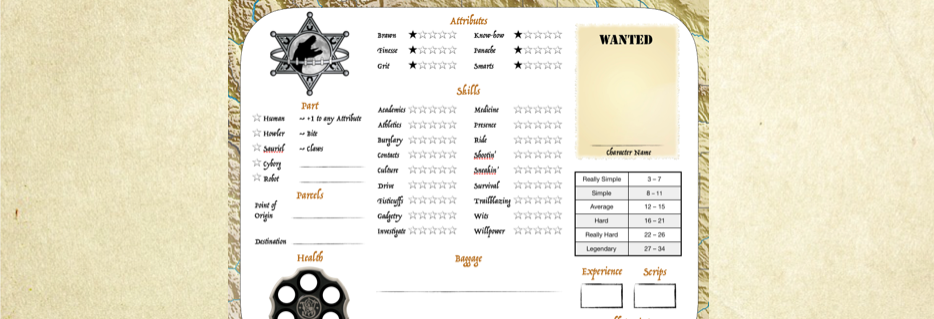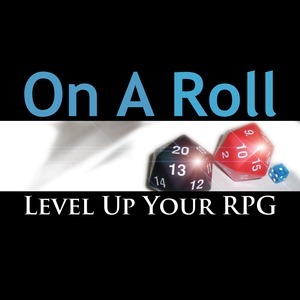Ryan has been developing a tabletop roleplaying game, The Gun Belt for over three years. The game features alien and robot cowboys riding dinosaurs in an interstellar Wild West on a world with no wheels. It is currently in the process of playtesting. This blog explores the process he and his design partner, Ashley, have experienced during that time.

Ashley is the rock star of the mechanical build for The Gun Belt. I’m fascinated by game theory and my understanding of how games, mechanics, players and game runners interact is something I’ve even published a book about, but math and statistics just aren’t my thing.
When we first began creating our own system, we each made a list of things we wanted and things we didn’t want in our game. These lists included theories, ideas and even the “feel” of some mechanics that we liked and disliked. We also made certain to include examples of the things we noted.
I love the character creation system in Magpie Games’ Masks that includes having players discuss with one another their connections with one another during session zero. I am also a fan of the old Last Unicorn Games’ Star Trek character creation process that included selecting Life Packages that encouraged players to really think about who their characters were when they were at differing stages of their lives. Drama points and Force points from the original 7th Seas and WEG Star Wars were also elements I really enjoyed because of the way they pushed the mechanics into a pool of extra possibilities that players could access simply because the moment was dramatic and right.
Things on my dislike list included the overcomplicated and confusing way that LUG Star Trek combined those Life Packages (if you’ve ever played that game, you know the seemingly algebraic complexities to which I refer). I hate character creation that takes more than about an hour – I want it fast and satisfying. I also have some negative feelings about complex die systems that use too much math and require proprietary dice (something I had struggled with as we explored using the Fate system early on).
Ashley’s list included a lot of his collaborative gaming likes. He’s a proponent of sourcing the table for information, empowering players to craft the story alongside the game runner and giving players a lot of narrative control, like in Kids on Bikes. _He also wanted something with a simple and clear core mechanic and he really wanted some sort of advantage and disadvantage system when rolling, like the system used in _D&D 5th Edition.
One of the things Ashley felt most strongly about was that he was not a fan of games that complicate their mechanics to a point that there is little to no wiggle room for game runners to make interpretations or involve players in things. He also felt that less is more with mechanics.
Something interesting we learned while researching different mechanical systems is that you can’t really copyright mechanics. This is generally a good thing, because it means that if you don’t want to reinvent the wheel, you don’t have to. You can gather all of the elements you like from all of the games you like, and then just mash them together and whittle them down until you have a system that does what you need in a way that you like. Embrace what you know works well and then mold it into your own game.
The Part and Parcel system is the core mechanical system we ended up with. At its simplest, it’s a die pool system in which players roll a few d6 and add those numbers to their character’s skill and attribute. There’s nothing groundbreaking there because it’s simple, it’s familiar and it works.
We started with six attributes, which eventually became four: Finesse, Grit, Know-how and Panache. Our skill list began as 20, then was paired down several times until we ended up with our list of ten that included standards such as Academics and Wits as well as more thematic skills like Fisticuffs, Gadgetry and Shootin’.
In addition, we have an advantage and disadvantage-inspired element in which characters get bonuses because they have an Upper Hand or are experiencing a Hurdle in attempting their action. The Gun Belt also features a narrative control element, Bullet Points – a pool of points shared by the entire group that can be spent to enhance the narrative, ignore negative affects or activate special abilities each character has.
Character creation was divided into four sections, granting skills and abilities based on a character’s youth experience and their current occupation in the world. These are supplemented by free points players can place anywhere. Finally, characters assign their Reputation based on the skills they are most proficient in and choose Faults that hinder them in the story.
At our last playtest, a table of five players created all of their characters in under 45 minutes.
Certainly, there’s a lot of playtesting that was done along the way (and that is still ongoing), but by utilizing familiar systems, theories and concepts, we’ve been able to move quickly past being bogged down in mechanics and focus on our world and how it interacts with our players.
Mechanics are part and parcel to a successful game, and we’re proud of what we’ve created. We think you’ll love it, too!
